Last month, the installation of the catalyst recirculation flow element was discussed as it related to the operation of the reactor ("Backwards Flow Measurement," page 12). In particular, the reactor was operated for approximately six months using flow measurements based upon a Venturi flow element installed backwards. (During a shutdown, it was "confirmed" that the Venturi was not touched). Part of the reason the meter was operated in this way for such an extended period of time was, in part, because the plant was waiting for another shutdown to correct the installation.
Shortly after my investigation, I observed the Venturi looked a bit "strange" because the inlet and outlet flanges did not appear to be parallel to one another. Further observation revealed that one of the welds in the Venturi was shinier than the others. My conclusion was that the Venturi was removed during the shutdown, cut, and re-welded before being reinstalled. More investigation revealed that the piping people had altered the Venturi in order to avoid altering the eight-meter pipe that they installed upstream because the small Venturi was easier to alter than the eight-meter pipe.
Needless to say, cutting and re-welding the Venturi affected the measurement accuracy of the Venturi flow element so a new Venturi had to be ordered. Delivery of this type of Venturi with hardened metal took a few months, so it was six months before the existing Venturi (installed backwards) could be replaced.
So we operated our reactor for about six months with its catalyst recirculation flowmeter installed backwards. You may think we were nuts, but under the circumstances it made a lot of sense. Sometimes, the cards you are dealt lead you in directions that may not seem logical to the outside observer. Has this ever happened to you?
David W. Spitzer is a regular contributor to Flow Control with more than 35 years of experience in specifying, building, installing, startup, troubleshooting and teaching process control instrumentation. Mr. Spitzer has written over 10 books and 150 technical articles about instrumentation and process control, including the popular “Consumer Guide” series that compares flowmeters by supplier. Mr. Spitzer is a principal in Spitzer and Boyes LLC, offering engineering, expert witness, development, marketing, and distribution consulting for manufacturing and automation companies. He can be reached at 845 623-1830.


